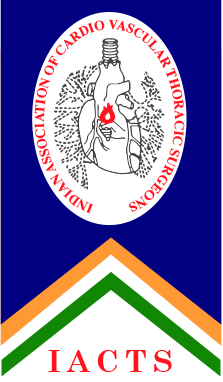

Video Submission Illustration by Dr. P. Narayan FRCS (Associate Editor-IJTCVS)
Copyright on all accepted manuscripts will be held by Indian Association of Cardiovascular and Thoracic Surgeons (IACTS). It is mandatory that the Copyright/Authorship Form is signed by all the authors, expressly transferring copyright to IACTS in the event the manuscript is accepted for publication.
Manuscript Submission
Submission of a manuscript implies: that the work described has not been published before; that it is not under consideration for publication anywhere else; that its publication has been approved by all co-authors, if any, as well as by the responsible authorities – tacitly or explicitly – at the institute where the work has been carried out. The publisher will not be held legally responsible should there be any claims for compensation.
Permissions
Authors wishing to include figures, tables, or text passages that have already been published elsewhere are required to obtain permission from the copyright owner(s) for both the print and online format and to include evidence that such permission has been granted when submitting their papers. Any material received without such evidence will be assumed to originate from the authors.
Online Submission
Please follow the hyperlink “Submit manuscript” on the right and upload all of your manuscript files following the instructions given on the screen.
Please ensure you provide all relevant editable source files. Failing to submit these source files might cause unnecessary delays in the review and production process.
Title Page
Please make sure your title page contains the following information.
Title
The title should be concise and informative.
If address information is provided with the affiliation(s) it will also be published.
For authors that are (temporarily) unaffiliated we will only capture their city and country of residence, not their e-mail address unless specifically requested.
Abstract
Please provide a structured abstract of 150 to 250 words which should be divided into the following sections:
For life science journals only (when applicable)
Trial registration number and date of registration
Trial registration number, date of registration followed by “retrospectively registered”
Keywords
Please provide 4 to 6 keywords which can be used for indexing purposes.
Declarations
All manuscripts must contain the following sections under the heading 'Declarations'.
If any of the sections are not relevant to your manuscript, please include the heading and write 'Not applicable' for that section.
To be used for all articles, including articles with biological applications
Funding
Information that explains whether and by whom the research was supported
Conflicts of interest/Competing interests
Include appropriate disclosures
Availability of data and material
Data transparency
Code availability
Software application or custom code
Authors' contributions
Optional: please review the submission guidelines from the journal whether statements are mandatory
Additional declarations for articles in life science journals that report the results of studies involving humans and/or animals
Ethics approval
Include appropriate approvals or waivers
Consent to participate
Include appropriate statements
Consent for publication
Include appropriate statements
Please see the relevant sections in the submission guidelines for further information as well as various examples of wording. Please revise/customize the sample statements according to your own needs.
Please note: All personal information (including names, email address, institution and prior publications) should be stated only in the title page and not even in a supplementary file.
Text Formatting
Manuscripts should be submitted in Word.
Headings
Please use no more than three levels of displayed headings.
Abbreviations
Abbreviations should be defined at first mention and used consistently thereafter.
Footnotes
If any of the sections are not relevant to your manuscript, please include the heading and write 'Not applicable' for that Footnotes can be used to give additional information, which may include the citation of a reference included in the reference list. They should not consist solely of a reference citation, and they should never include the bibliographic details of a reference. They should also not contain any figures or tables.
Footnotes to the text are numbered consecutively; those to tables should be indicated by superscript lower-case letters (or asterisks for significance values and other statistical data). Footnotes to the title or the authors of the article are not given reference symbols.
Always use footnotes instead of endnotes.
Acknowledgments
Acknowledgments of people, grants, funds, etc. should be placed in a separate section on the title page. The names of funding organizations should be written in full.
References
Citation
Reference citations in the text should be identified by numbers in square brackets. Some examples:
Reference list
The list of references should only include works that are cited in the text and that have been published or accepted for publication. Personal communications and unpublished works should only be mentioned in the text. Do not use footnotes or endnotes as a substitute for a reference list.
The entries in the list should be numbered consecutively.
If available, please always include DOI numbers or full DOI links in your reference list.
Always use the standard abbreviation of a journal’s name according to the ISSN List of Title Word Abbreviations, see
ISSN.org LTWA
If you are unsure, please use the full journal title.
For authors using EndNote, Springer provides an output style that supports the formatting of in-text citations and reference list.
EndNote style (Download zip, 4 kB)